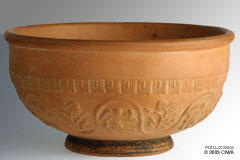Sigillated bowl, Roman Gaul, 100-150 AD

Links to other views:⇒ Larger Viewif scripting is off, click the ⇒ instead. Links to others of type BowlBronze bowl, Sasanian Persia, 224-650 ADBronze bowl with ibexes, Luristan, 900-700 BC Bronze bowl with omphalos, Persia, 559-334 BC Bronze bowl with omphalos, Persia, 559-500 BC Double-convex bowl, Roman, 100-200 AD Early-dynastic alabaster bowl, 3100-2686 BC Grooved bowl, Syro-Palestine, 150-50 BC Large glass bowl, Roman world Large silver bowl, Sasanian Persia, 226-637 AD Ribbed bronze bowl, Persia, 559-334 BC Ribbed glass bowl, Alexandria, 50 BC-50 AD |
This sigillated pottery bowl was made in Eastern Gaul. It bears the mark of the potter Verecundus, whose shop was in a town known for its pottery industry from 100 to 150 AD, and now known as Itenviller (south of today’s Strasbourg, France). The sigillated (meaning impressed with stamps) red-gloss pottery technique was initially developed in Arretium (now Arezzo in Italy), then brought to Roman Gaul where it became a significant activity during the second half of the first century AD. “When the final decoration of the mold was complete (which in many instances included working in the names of the artist-potter) the whole was fired in a kiln. The product was a deep hemispherical bowl with rather thick walls. Once prepared, the mold would be placed on a potter’s wheel and very finely levigated (sifted and puddled) clay would be pressed into the intaglio impressions, keeping the inner skin smooth and relatively thin… The whole was then left to dry… The red coloring is the product of iron oxides, hence only an iron bearing clay would achieve the desired effect. The pot would be coated either by painting or by pouring the gloss all over it, or it would be dipped. Once the gloss was dry, the pot was ready to be fired in a kiln… The resultant piece was a handsome object, as much prized in antiquity as they are now” (Clayton 1986:168-170). Bibliography (for this item)Clayton, Peter1986 Treasures of Ancient Rome. Gallery Books, New York, NY. ( 168-175) |